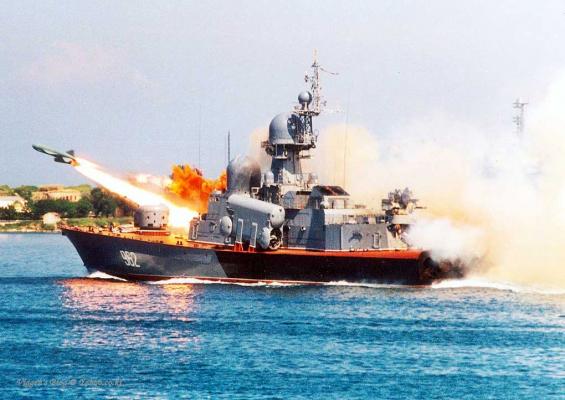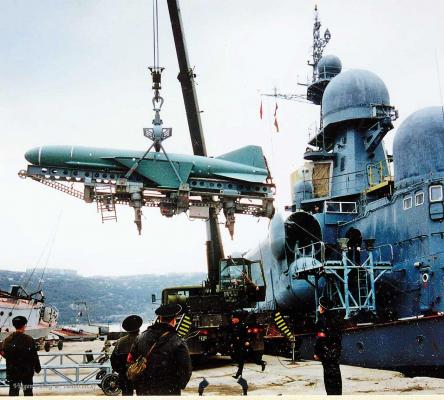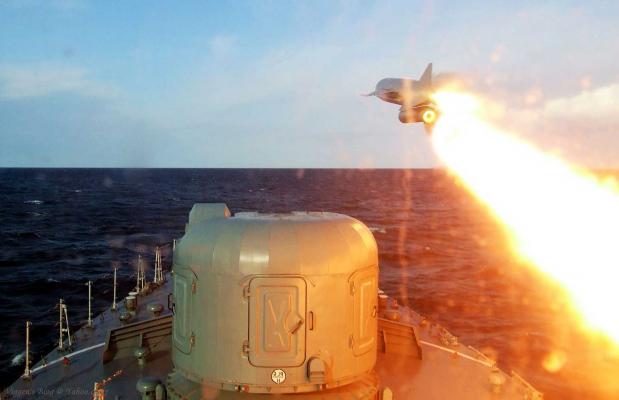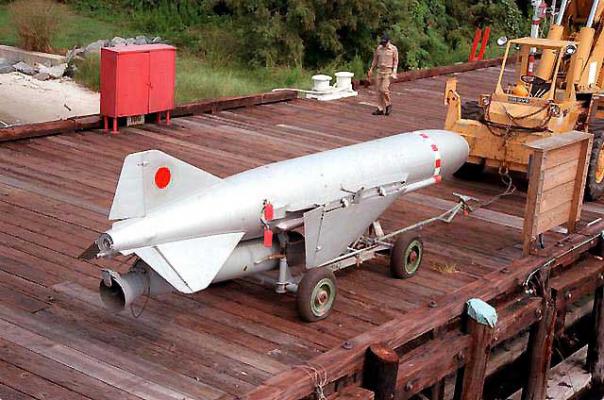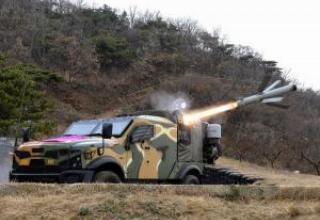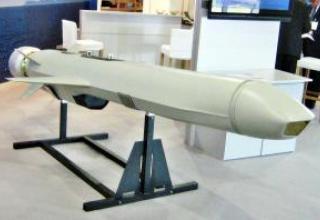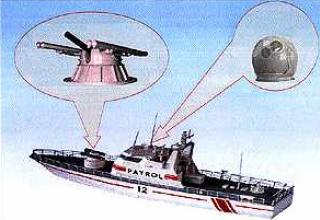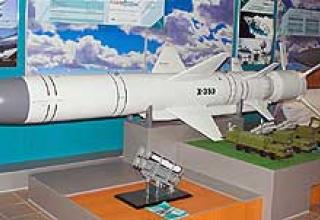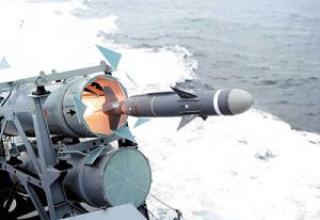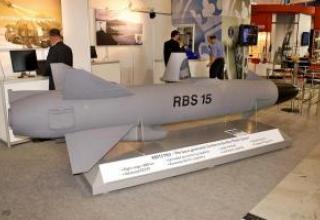The P-15 anti-ship missile was developed in 1955-1960 at the Raduga Design Bureau under the leadership of A.Y.Bereznyak.
As a carrier ship for P-15 missiles was originally adopted by the torpedo boat project 183, which instead of torpedo tubes and the stern artillery 2M-ZM (the bow was preserved), mounted two hangar-type launchers for missiles P-15. Specially for testing of P-15 missiles at the plant № 5 ("Almaz") was built two pilot boats of project 183E. The first launch of the P-15 missile from a boat project 183E was held October 16, 1957 in the Black Sea.
Officially, the P-15 missile system was adopted in 1960, but at the end of 1958 the construction of missile boats of project 183P was deployed at two plants and lasted almost 9 years. Totally at the end of 1965, 112 boats of 183R project were built. Among them 6 boats were delivered to Algeria, 6 to Egypt, 9 to Indonesia, 18 to Cuba, 10 to DPRK, 20 to China (then they were built there under license), 6 to Syria, etc.
Except for the boats of pr. In addition to the 183R rockets of the P-15 family, there were 205M Wasp boats of Project 1241.1, six large anti-submarine ships of Project 61M (four launchers), five large anti-submarine ships of Project 61-ME (four launchers) built for India, and three destroyers of Project 56-U (four launchers).
Over the years of service, the P-15 complex has been upgraded on several occasions. In 1972, the Termit complex with the P-15M missile was adopted for service. The modification of P-15M missile was also used in the mobile coastal defense complex "Rubezh".
Composition:
The P-15 missile (see diagram, photo 1, photo 2) had a normal aerodynamic pattern with a mid-range trapezoidal wing of relatively small elongation and a large sweep at the front edge, an upper-range developed keel and all-terrain elevation rudders. The heel was controlled by wing ailerons. At the tail end of the hull there were two additional V-shaped aerodynamic ridges, between which a powder accelerator SPRD-30 designed by I.I.Kartukov was suspended to the rocket. The thrust of the starting engine was 28-30 tons.
P-15 was equipped with a liquid-propellant marching jet engine, which was created under the leadership of A.M.Isaev. The engine was powered by TG-02 fuel and AK-20K oxidizer and had two operating modes: acceleration and "speed maintenance" mode.
The P-15 missile had an autonomous guidance system, which consisted of the AM-15A autopilot, barometric altimeter and a homing radar head. Later, the barometric altimeter was replaced by a radio altimeter, which allowed flying lower, or more precisely, to visualize the course in height. The P-15 missile was equipped with the 4G15 high-explosive high-explosive warhead developed at the Research Institute-6 of the GKOT.
The boat of project 183R "Komar" (see the scheme) had an unflooded hangar-type launcher (the wings of the missile did not fold). The beam-type launcher rails were rigidly fixed at an angle of 11.5°. The length of the guide rails was originally 4.5 m and then was shortened to 2.75 m. The weight of the launcher was 1,100 kg. According to the project boat project 183R could launch missiles at speeds from 15 to 30 knots and the state of the sea to 4 points. The reloading of the launchers was carried out in the base, with one missile taking about 30 minutes.
On the boat 183R was placed PUS "Maple", which received data from the radar "Rangout". The function of the PUS was to work out the combat course of the boat and keep it on course, working out the time of autonomous flight of the missile, the parameters of the onboard and keel swing to stabilize the missile, etc. Optical vizier PMC-453 served as a backup target designation tool.
In 1961, SKB-5 developed the design of the 205U boat, in which the bulky missile hangars were replaced by smaller cylindrical KT-97M containers. Such containers not only won the size of the hangars (less than 1 m in length and 0.8 m in width), but also provided a microclimate for the missile (due to tightness) and could be quickly replaced if necessary. The introduction of cylindrical containers became possible after the modernization of the missile P-15 in P-15U, during which the wing began to automatically open when flying out of the container, like a missile P-5. Testing of the missile P-15U began in 1961, and it was adopted for service in 1965. P-15U missile received the index 4K-40U.
Even before the P-15 missiles were adopted for service, the development of thermal homing heads for them began. From August 29, 1959 to October 28, 1959 on boats of project 183E were tested missile P-15TG with a thermal passive homing head "Condor" - the first in the USSR 24-hour thermal head. In the search mode, the lens of the Condor head receiving device moved at a rate of + 2.5°. During the tests it was found that the range of the Condor head on a target with a thermal mode corresponding to the cruiser, at a speed of 24 knots is 10 km during the day and 5 km at night. In total, 10 P-15TG missiles were launched. In general, the tests were successful, although in one launch the launch accelerator did not separate and the rocket did not reach the target. According to the results of the tests, the P-15TG missile with the Condor head was recommended for adoption into service.
Shortened launcher guides were also tested during the same firing process. The first launch was with 4.5m rails and the subsequent launches with 2.75m rails. Tests showed that it was possible to shoot with short rails.
P-15M "Termit" missile is an improved version of P-15U missile with extended range. The missile has an inertial control system that operates on the march section of the flight and two versions of the active CNS: active radar (ARL CNS) and infrared (IR CNS) type "Snegir-M". The CLO operates on the final portion of the missile's flight, the homing portion. The missile can be equipped with a 513 kg BC blast weight (explosive weight 375 kg) or 15 Kt nuclear power. The height of the missile's flight (25 - 50 - 250 m) is set before launch. According to advertising data, when approaching the target, the missile is reduced to a height of 2.5 m above the wave level.
On the modified boat of project 205M four KT-97B launchers were placed, on the boat of project 1241.1 two KT-138 launchers were placed. The KASU of these boats included a radar for detection and targeting "Rangout", firing support equipment according to KVNP "Avangard", firing control devices "Maple-205UM", agroindustrial complex "DK-131A" with start chain devices, identification system "Password". The set of ground equipment included: transport and loading facilities, technological equipment, "DK-150" missile PPA.
For boats of project 205M and 1241.1 the combat application was provided at sea disturbance up to 5 points, air temperature from -20 to +40°C, true wind speed of any direction up to 15m/s, on-board rocking ±20°, keel rocking ±15°, constant boat roll up to 6°, shooting boat speed and target speed up to 50 knots. The minimum distance of the boat from the obstacle (island, ridge, cape, etc.) shall not be less than 6 km and the obstacle itself shall not be in the zone where the homing head of the missile is already on, the height of the obstacle shall not be more than 10m with the missile flight height of 25m and not more than 30m with the flight height of 50m.
Characteristics:
| P-15 | P-15M "Termite" | |
| Number of simultaneously fired targets | 1 | 1 |
| Number of rockets in salvo | 4 | 4 |
| Interval between launches | 5-10 | 5-10 |
| Range of fire, km : - maximum - minimum |
35-40 8 |
80 8 |
| Marching speed, m/s | 320 | 320 |
| Flight marching altitude, m | 100-200 | 25/50 |
| The length of the rocket with the starting engine, m | 6.55 | 6.67 |
| Wingspan, m | - | 2.4 |
| Hull diameter, m | 0.76 | 0.76 |
| Missile launch weight, kg | 2125 | 2573 |
| Starting accelerator weight, kg | 490 | 490 |
| Weight of combat unit, kg | 480 | 513 |
| Pre-start preparation time, s | 240 | 240 |
| Target detection range of the destroyer type, km | 24 | 40 (horizon mode - 100) |
Testing:
On 21 October 1967, the Israeli destroyer Eilat, with a displacement of 1,710 tons, was hit by P-15 missiles fired from Egyptian Komar-type missile boats parked in Port Said. Of Eilat's 202 crew members, 47 were killed and 91 injured. This was the first time that anti-ship missiles were used, although the parties' versions differed.
- According to the Israeli military, Eilat was 22 km from Port Said, 3 km from Egyptian territorial waters, when it was struck by two P-15 Termit missiles. After the hit, Eilat turned the keel upside down but did not sink. Two hours later, the Egyptians, seeing that the ship was still afloat, fired two more rockets, one of which launched the ship to the bottom and the other exploded on the water surface, injuring and killing many crew members.
- According to the Egyptian side, the Eilat was 16 km from Port Said, inside Egyptian territorial waters. Only two rockets were fired, which proved to be enough to immediately sink an Israeli ship.
Since 1974, China began licensed production of P-15M. These missiles received the designation HY-1 (NATO designation - "Silkworm") and have since been repeatedly upgraded and sold to various countries.
Soviet and Chinese-made P-15 family missiles were used during the 1971 Arab-Israeli War, the 1971 Indo-Pakistani conflict, and the 1980-1988 Irano-Araks war.
On October 15, 1987, during the "tanker" war in the Persian Gulf, the Iranian missile "Silkworm" launched from the Fao Peninsula hit the Liberian tanker "Sungari" anchored off the coast of Kuwait.
During Operation Desert Storm, two Iraqi P-15 missiles were used against a U.S. liquor, the Missouri, which was firing at the Iraqi coast. One of the missiles was diverted by radio interceptors and the other was hit by a Sea Dart anti-aircraft missile from the English frigate Gloucester. This is the first time that an anti-ship missile has been intercepted in a combat environment.
Iran started its own production of similar missiles (FL-10) with China's assistance in 1996.
Sources:
- А.Б.Широкорад "Оружие отечественного флота", Минск, Харвест, 2001г.
- http://www.fas.org
